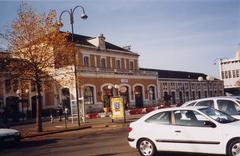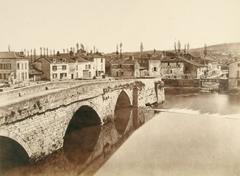
Périgueux Amphitheatre: Visiting Hours, Tickets, and Historical Site Guide
Date: 04/07/2025
Introduction
The Périgueux Amphitheatre (Arènes de Périgueux) is a striking remnant of Roman Gaul, located in the heart of southwestern France. As one of the largest Roman amphitheatres in the region, it offers visitors a window into the ancient city of Vesunna—today’s Périgueux—and stands as a testament to the area’s rich archaeological and cultural heritage. Integrated within the tranquil Jardin des Arènes, the site is a must-visit for history lovers, families, and anyone exploring the Dordogne.
This guide provides comprehensive, up-to-date information on visiting hours, tickets, accessibility, nearby attractions, and expert travel tips to ensure a rewarding visit to this iconic historical site (Travel France Online; Waymarking; Guide Tourisme France).
The Roman Origins and Transformation of the Amphitheatre
Construction and Early Use
Built in the 1st or 2nd century AD, the Périgueux Amphitheatre was designed during a period of Roman expansion and urbanization. Its elliptical arena, measuring roughly 130–141 meters in length and 100–118 meters in width, could welcome up to 18,000–20,000 spectators—making it one of the largest in Roman Gaul (Guide Tourisme France). The amphitheatre hosted gladiatorial combats, animal hunts (venationes), and public spectacles, serving as both a center of entertainment and a symbol of Roman civic pride.
Medieval Repurposing and Preservation
With the decline of Roman power, the amphitheatre’s function shifted. Its robust structure made it a strategic fortress during the Middle Ages. Later, its stones were quarried for local construction, and in the 17th century, the site was entrusted to the Visitandines religious order. In the 19th century, the ruins were officially protected as a historical monument, and the area was transformed into the Jardin des Arènes, integrating the ancient remains into a landscaped public park (Monumentum).
Architectural Features
Despite centuries of change, key elements of the amphitheatre remain visible. Visitors can observe sections of the original stone seating (cavea), the arena outline, and some of the arched corridors (vomitoria) that facilitated crowd movement. Interpretive panels throughout the park provide context on the amphitheatre’s construction and role in Roman Vesunna (Sac à Voyage).
Visitor Information
Location and Access
- Address: 28 Boulevard des Arènes, 24000 Périgueux (Monumentum)
- Getting There: The site is easily accessible on foot from central Périgueux and the SNCF train station (approx. 15 minutes). Public parking is available nearby, though it can be limited during peak times (Everything Dordogne).
Opening Hours
- General Access: As part of the Jardin des Arènes, the amphitheatre is open year-round during daylight hours (from dawn to dusk). There are no strict entrance or closing times, offering flexibility for visitors.
- Guided Tours and Events: Some sections may be temporarily restricted during maintenance or special events. For updates, consult the Grand Périgueux Tourist Office.
Tickets and Admission
- Entry: Access to the amphitheatre and public park is free—no tickets or advance booking required.
- Guided Tours: The tourist office offers guided tours (often available in English and French) for a fee, especially during European Heritage Days and other local festivals. Advance booking is recommended (Monumentum).
Facilities and Accessibility
- Amenities: The park features benches, shaded areas, walking paths, and nearby public restrooms. Cafés and restaurants are within walking distance.
- Accessibility: Paths are paved and mostly flat, making the site accessible for wheelchairs and strollers. Some uneven terrain exists near the ruins; visitors with mobility needs should contact the tourist office for assistance.
Enhancing Your Visit: Travel Tips and Nearby Attractions
Best Time to Visit
- Season: Late spring to early autumn (May–September) is ideal for pleasant weather and vibrant gardens.
- Timing: Early morning or late afternoon provides optimal light for photography and fewer crowds (Sac à Voyage).
Combine with Other Sites
- Vesunna Gallo-Roman Museum: Interactive exhibits and a preserved Roman villa just minutes from the amphitheatre (Everything Dordogne).
- Saint-Front Cathedral: UNESCO-listed, with guided rooftop tours offering panoramic views.
- Tour de Vésone: Remnants of a Roman temple, another essential stop for archaeology enthusiasts.
Events and Activities
- Cultural Events: The park hosts open-air concerts, performances (including the MIMOS Festival), and special events throughout the year (Destination Périgueux).
- Family Activities: During school holidays, the tourist office organizes themed workshops and treasure hunts for children.
Photography Tips
- Lighting: Capture dramatic shadows and vibrant colors during golden hour.
- Angles: Explore various perspectives—close-ups of stonework, wide shots of the arena, and cityscape vistas from higher vantage points.
Local Gastronomy
- Market Days: Wednesdays and Saturdays feature bustling markets in Place de la Clautre, perfect for sampling regional specialties like truffles, foie gras, and pâté.
- Picnics: The Jardin des Arènes is ideal for a picnic lunch amid historic surroundings.
Frequently Asked Questions (FAQ)
Q: Are tickets required to visit the Périgueux Amphitheatre?
A: No, the site is free to access. Guided tours and special events may require tickets.
Q: What are the opening hours?
A: The site is generally open from dawn to dusk year-round. Check the tourist office website for any temporary changes.
Q: Is the site accessible for visitors with limited mobility?
A: Yes, most paths are paved and suitable for wheelchairs and strollers, though caution is advised near uneven areas.
Q: Are guided tours available in English?
A: Yes, the tourist office offers tours in English and French. Book in advance for guaranteed spots.
Q: Can I bring my dog?
A: Dogs are allowed on leash in the park.
Q: Are there places to eat nearby?
A: Numerous cafés, bakeries, and restaurants are within walking distance.
Responsible Tourism and Site Preservation
Please respect the historical site by staying on marked paths, not climbing on the ruins, and supervising children. The amphitheatre is a protected monument, and preservation ensures its legacy for future generations (Guide Tourisme France).
Visuals and Media Suggestions
- Images: Photos of the amphitheatre ruins and Jardin des Arènes, with alt text such as “Périgueux Amphitheatre ruins surrounded by blooming gardens.”
- Maps: Include a map showing the amphitheatre’s location and nearby attractions.
- Virtual Tours: Refer to the Grand Périgueux Tourist Office website for virtual tours and galleries.
Internal Links (Suggestions)
Key Takeaways and Recommendations
- The Périgueux Amphitheatre is a free, accessible landmark central to the city’s Roman legacy.
- Combine your visit with the Vesunna Museum and Saint-Front Cathedral for a full historical experience.
- Check the tourist office for guided tours, events, and the latest visitor information.
- Download the Audiala app for interactive guides and follow our updates for travel inspiration.
For the latest details on visiting hours, tickets, and events, consult the official Grand Périgueux tourism website.
Sources
- Travel France Online
- Waymarking
- Guide Tourisme France
- Monumentum
- Guide du Périgord
- Tourisme Grand Périgueux


